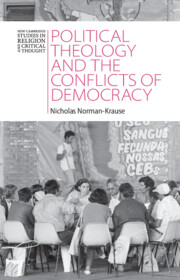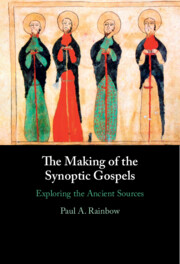155 results
1 - Augustinianisms and Liberalisms
-
- Book:
- Political Theology and the Conflicts of Democracy
- Published online:
- 21 March 2025
- Print publication:
- 03 April 2025, pp 35-94
-
- Chapter
- Export citation
Introduction
-
- Book:
- Political Theology and the Conflicts of Democracy
- Published online:
- 21 March 2025
- Print publication:
- 03 April 2025, pp 1-34
-
- Chapter
- Export citation
5 - Loving in Conflict
-
- Book:
- Political Theology and the Conflicts of Democracy
- Published online:
- 21 March 2025
- Print publication:
- 03 April 2025, pp 280-326
-
- Chapter
- Export citation

Political Theology and the Conflicts of Democracy
-
- Published online:
- 21 March 2025
- Print publication:
- 03 April 2025
29 - The Medieval Papacy and the Jews
- from Part V - Inter-Faith Relations: Confrontation and Dialogue
-
-
- Book:
- The Cambridge History of the Papacy
- Published online:
- 28 February 2025
- Print publication:
- 20 March 2025, pp 747-769
-
- Chapter
- Export citation
3 - The City in Question
-
- Book:
- The Idea of the City in Late Antiquity
- Published online:
- 30 January 2025
- Print publication:
- 27 February 2025, pp 74-114
-
- Chapter
- Export citation
Lucifer’s disordered love and the first-person perspective: an Augustinian account of primal sin
-
- Journal:
- Religious Studies , First View
- Published online by Cambridge University Press:
- 02 January 2025, pp. 1-26
-
- Article
- Export citation

The Making of the Synoptic Gospels
- Exploring the Ancient Sources
-
- Published online:
- 21 November 2024
- Print publication:
- 28 November 2024
Chapter 5 - Making toward God
- from Part II - Myth and Culture
-
- Book:
- Theology and the Mythic Sensibility
- Published online:
- 07 November 2024
- Print publication:
- 21 November 2024, pp 90-112
-
- Chapter
- Export citation
We Deserve It: An Augustinian Response to Divine Hiddenness Arguments
-
- Journal:
- New Blackfriars / Volume 105 / Issue 6 / November 2024
- Published online by Cambridge University Press:
- 21 October 2024, pp. 636-650
- Print publication:
- November 2024
-
- Article
-
- You have access
- Open access
- HTML
- Export citation
1 - Religious Controversy and Conversion in Vandal Africa
-
- Book:
- Conversion and the Contest of Creeds in Early Medieval Christianity
- Published online:
- 06 June 2024
- Print publication:
- 13 June 2024, pp 25-42
-
- Chapter
- Export citation
Chapter 9 - A Consolation through Philosophical Insight?
-
-
- Book:
- Boethius’ ‘Consolation of Philosophy’
- Published online:
- 23 May 2024
- Print publication:
- 30 May 2024, pp 153-168
-
- Chapter
- Export citation
“You Adore a God Who Makes You Gods”: Augustine’s Doctrine of Deification
-
- Article
-
- You have access
- HTML
- Export citation
Chapter 5 - An Alternative View
-
- Book:
- Popular Culture and the End of Antiquity in Southern Gaul, c. 400–550
- Published online:
- 15 March 2024
- Print publication:
- 28 March 2024, pp 144-172
-
- Chapter
- Export citation
9 - The Evolution of Religiosity
-
- Book:
- Exploring Religious Pluralism
- Published online:
- 14 March 2024
- Print publication:
- 21 March 2024, pp 135-154
-
- Chapter
- Export citation
What Might Agamben Learn from Augustine?
-
- Journal:
- New Blackfriars / Volume 105 / Issue 3 / May 2024
- Published online by Cambridge University Press:
- 20 March 2024, pp. 309-325
- Print publication:
- May 2024
-
- Article
-
- You have access
- HTML
- Export citation
1 - What Is ‘Religion’, What Is ‘Theosis’, and How Are They Related?
-
- Book:
- Theosis and Religion
- Published online:
- 07 March 2024
- Print publication:
- 14 March 2024, pp 9-33
-
- Chapter
- Export citation
Chapter 13 - Philosophy
-
-
- Book:
- The Cambridge Critical Guide to Latin Literature
- Published online:
- 04 January 2024
- Print publication:
- 18 January 2024, pp 700-752
-
- Chapter
- Export citation
4 - Aquinas’s Account of Creation
-
- Book:
- Theistic Evolution
- Published online:
- 19 October 2023
- Print publication:
- 02 November 2023, pp 127-155
-
- Chapter
- Export citation
23 - Precision and the Limits of Autopsy in Augustine’s Critique of Pagan Divination
-
-
- Book:
- The Intellectual World of Late Antique Christianity
- Published online:
- 05 October 2023
- Print publication:
- 26 October 2023, pp 426-442
-
- Chapter
- Export citation


